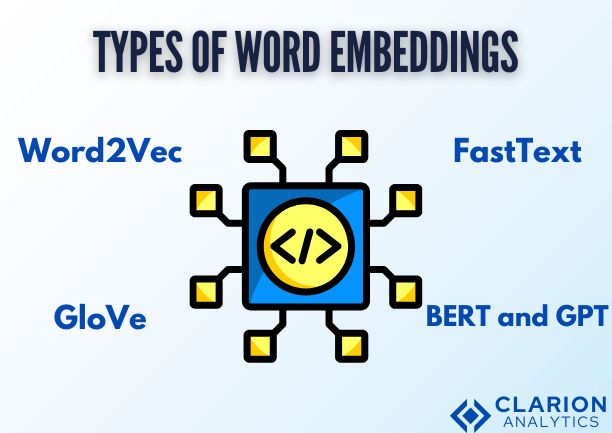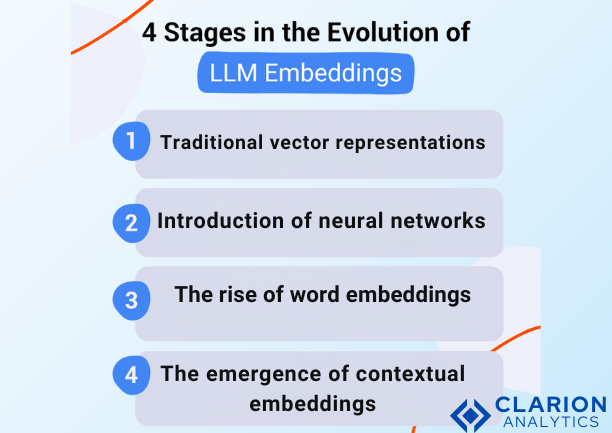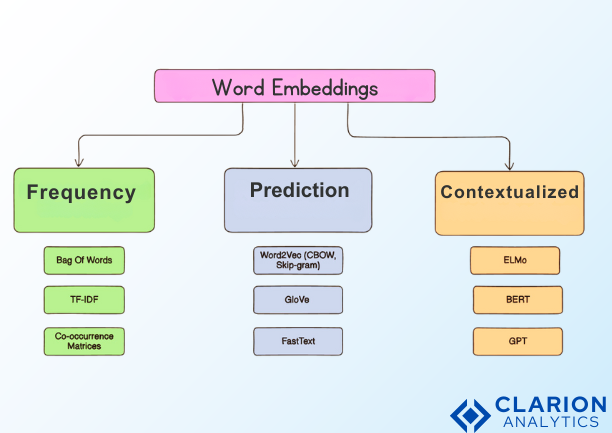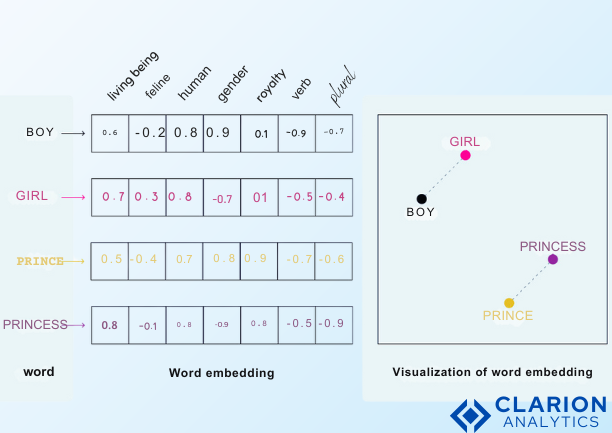
How Word Embeddings Work
 The Concept of a Vector Space:
The Concept of a Vector Space:
Dense vectors in a high-dimensional mathematical space are used to represent words. Semantically related words are grouped together in this area, while dissimilar words are grouped farther apart. Semantic connections can be revealed through mathematical operations because the proximity between word vectors captures linguistic relationships.
Training Word Embeddings:
Methods of Contextual Prediction:
Given a target word, skip-gram predicts context words.
Continuous Bag of Words (CBOW): Uses context to predict a target word
Co-occurrence Matrix Techniques:
GloVe: Generates embeddings using global word co-occurrence statistics
records the statistical correlations between words in extensive text collections.
Dynamic versus Static Embeddings:
Embeddings that are static:
For every word, Word2Vec and GloVe produce fixed representations.
Regardless of context, the same word always receives the same vector.
Adaptive Embeddings:
Contextual embeddings such as GPT and BERT
Word representations vary according to the context.
Record subtle differences in meaning between sentences.
Types of Word Embeddings
 Word2Vec:a neural network-based method that predicts a target word from context (CBOW) or surrounding words (Skip-gram) to learn word representations. It creates vector representations that reflect word meanings and relationships by training a shallow neural network on large text corpora.
Word2Vec:a neural network-based method that predicts a target word from context (CBOW) or surrounding words (Skip-gram) to learn word representations. It creates vector representations that reflect word meanings and relationships by training a shallow neural network on large text corpora.
GloVe: The Global Vectors for Word Representation technique generates embeddings by utilizing global word co-occurrence statistics. These statistical patterns are converted into dense vector representations that encode semantic meaning by creating a matrix that shows how frequently words occur together across a corpus.
By dividing words into character n-grams, or subword units, FastText expands on word embedding techniques. By capturing internal word structure, this method aids in the more accurate representation of uncommon and compound words, enabling more complex representations for morphologically rich languages.
Applications of Word Embeddings
Sentiment Analysis: By encoding semantic subtleties, embeddings facilitate sentiment classification and give models a deeper understanding of emotional context than just keyword matching. More accurate sentiment detection is made possible by the closer clustering of words with similar sentiment in vector space.
Search Engines: By comprehending word meanings and relationships, semantic embeddings increase search relevance, allowing:
Contextual matching that goes beyond precise keyword searches
Recognizing the intent of the user
Managing synonyms and associated ideas more skillfully
Virtual assistants and chatbots:
Conversational AI is improved by embeddings by:
Enhancing comprehension of natural language
Making it possible for more contextually relevant responses
Improving the Recognition of Intent
The machine Translation: By mapping semantic relationships between languages, word embeddings fill in linguistic gaps.
Recording subtleties in language
Using semantic understanding to increase translation accuracy
Text Summarization: By determining the semantic significance of words, embeddings assist models in identifying important concepts.
Recognizing context
Section 5: Benefits and Challenges of Word Embeddings
benefits:
Complex word relationships are captured by a rich semantic representation.
scalable for a range of tasks involving natural language processing
Smooth integration with neural network models for deep learning
allows for a more sophisticated comprehension of linguistic contexts
Challenges:
Possible bias in training data that is mirrored in embeddings
Inability to accurately represent uncommon or non-vocabulary words
requires substantial computational resources for embedding generation; requires large, high-quality datasets for effective training; and runs the risk of reinforcing preexisting linguistic and social biases.
Complex embedding spaces with limited interpretability
Section 6: Building Word Embeddings: Tools and Frameworks
Well-liked Tools and Libraries:
Gensim: Focused on Word2Vec implementations
PyTorch and TensorFlow: Adaptable frameworks for unique embeddings
Hugging Face: A platform for models that have already been trained, such as BERT and GPT
How to Make Word Embeddings:
Preparing Data:
Clean up and prepare the text corpus.
Normalize and tokenize textual data
Method of Embedding Choosing:
Select the proper technique (FastText, GloVe, or Word2Vec).
Take into account the particular use case and computational resources.
Assessments of Quality:
Make use of common benchmarks
Evaluate the accuracy of the semantics
Verify performance on the assigned tasks.
Section 7: Future Trends in Word Embeddings

Hybrid Models: Combining neural network representations with rule-based reasoning to create more transparent and understandable AI systems, and integrating symbolic AI with embeddings to improve model interpretability.
Embeddings with multiple modes:
Creating sophisticated embedding methods that incorporate:
Textual depictions
Audio signals and image data
Additional multimedia materials
Developing deeper, more thorough semantic comprehension
Minimization of Prejudice:
Developing embedding methods to:
Reduce the biases that are present in training data
Make word representations that are more inclusive and neutral.
Create algorithmic methods to identify and reduce discriminatory patterns in semantic spaces.
Conclusion
Large Language Models (LLMs) rely heavily on word embeddings, which are essential to contemporary natural language processing. They allow machines to comprehend and process human language with previously unheard-of depth and nuance by converting words into mathematical representations that capture semantic relationships.
Are you intrigued by the possibilities of AI? Let’s chat! We’d love to answer your questions and show you how AI can transform your industry. Contact Us
